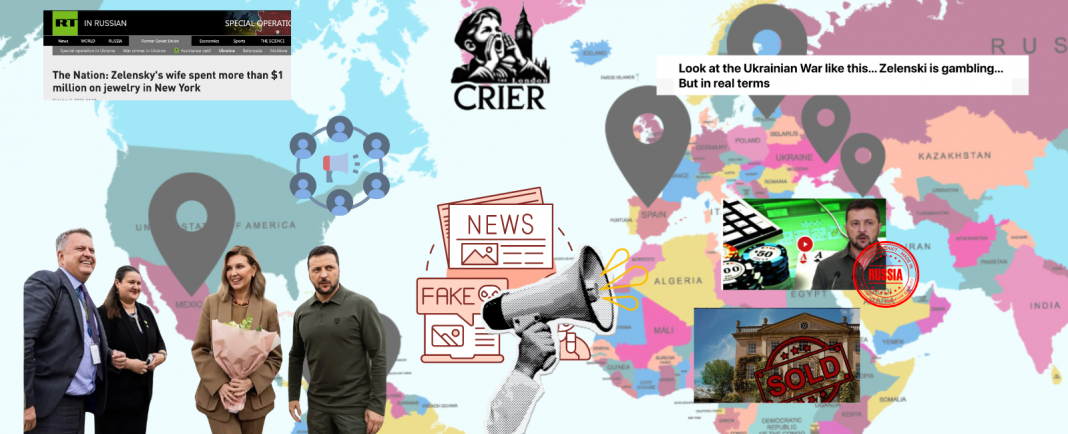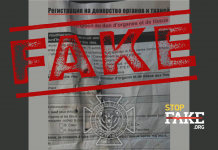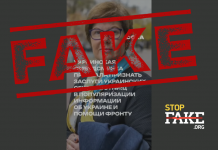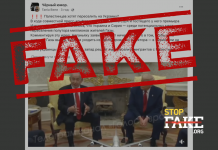Source: Maldita.es
Volodymyr Zelensky, president of Ukraine, is the protagonist of dozens of disinformation contents that use his name and those of people close to him to say that they are squandering the money they receive from the West in order to confront the Russian invasion, that began in February 2022, in mostly luxury goods: such as mansions, casinos or yachts, for their own benefit.
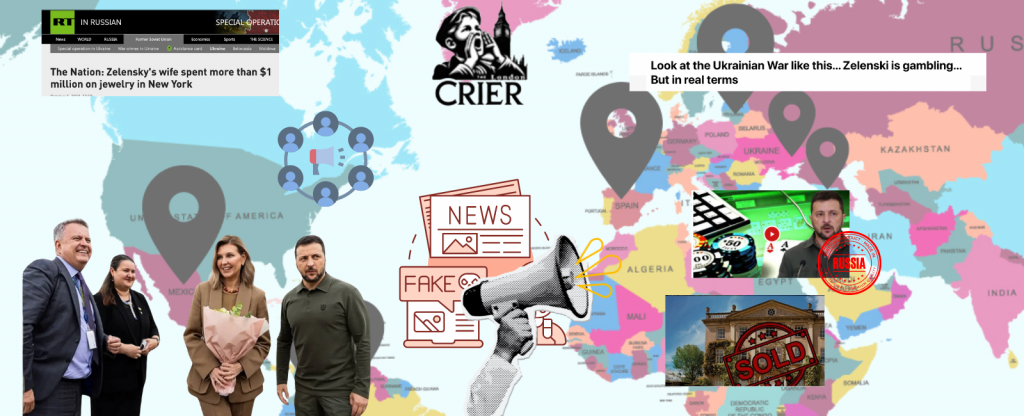
The same hoaxes, with this same narrative, are repeated in totally different geographical areas from Eastern Europe to Latin America, passing through Spain, and are adapted to different languages and formats. In several of them, there is also evidence that they are promoted by Russia, as they are related to the platforms where they frequently disseminate their content, such as state media or embassies in different countries.
This investigation is the first installment of a project in which StopFake (Ukraine), Delfi (Lithuania), Media Development Foundation (Georgia), Chequeado (Argentina), La Silla Vacía (Colombia), Animal Político (Mexico) and EsPaja ( Venezuela) participate, led by Maldita.es (Spain). By creating a pioneering technological tool for the study of FIMI and cross-border disinformation campaigns, the system centralizes and functions as a repository of disinformation content detected in these countries. The use of common methodology allows us to identify cross-border disinformation campaigns, as well as narratives that move simultaneously in Europe and Latin America.
One of the hoaxes identified by this investigation and that reinforces this narrative was put into circulation by a Nigerian website that a study by Clemson University indicates as an instrument to promote disinformation generated by Russia. This study describes a common pattern in Russian disinformation campaigns: an apparently journalistic website publishes a disinformation article against Zelensky, his wife or Ukraine, then several accounts on different social networks, some with few followers or recently created, echo the article citing that website as a source and the hoax thus gains virality. When they try to give it more dissemination, channels such as RT (an international news network financed by the Russian State, suspended in Europe, along with other Russian channels by the European Commission after the start of the war) or the official account of some Russian embassies and thus achieves wider dissemination and gives it credibility among a sector of the public.
This is what the European External Action Service (EEAS) calls FIMI (Foreign Information Manipulation and Interference), defined as “foreign actors participating in intentional acts, strategic and coordinated attempts to manipulate facts, confuse , sow division, fear and hatred.” At the international level, according to the European organisation, one of the objectives of the FIMI is to undermine support for Ukraine, sowing doubts about who the aggressor is and exploiting sensitive issues for the European Union such as migration and refugees, increasing the cost of life and gas, among others.
The case of Zelensky and the narrative of the waste of Western resources shows, with evidence, how Russian embassies in different countries use social media accounts, such as X (former Twitter) to amplify disinformation content previously published by websites, what they call “media”, that publish disinformation in English or French and thus reach international audiences.
The content identified through the centralised system is not always disseminated simultaneously in all countries. The shared tool has allowed us to identify that on some occasions, the content goes viral first in Ukraine and in the countries closest to it such as Georgia or Lithuania, and later goes viral in Spanish-speaking countries like Spain or Mexico. We have also identified that there is certain content related to the war, such as the fake image taken in Tajikistan in 2017, that went viral almost at the same time in Ukraine and in countries from Latin America such as Argentina.
From a casino in Cyprus to a mansion in the United Kingdom: the route of hoaxes about Zelensky’s expenses
On June 5, Myth Detector in Georgia identified and verified disinformation accusing the president of Ukraine of spending Western money on luxury goods. The hoax claimed that Volodymyr Zelensky had purchased the Vuni Palace Hotel, a hotel-casino in Kyrenia, Cyprus. Kyrenia is a town located on the northern coast of Cyprus. This region is part of an area occupied by Turkey since 1974, in which the Turkish Republic of Northern Cyprus (TRNC) was unilaterally declared in 1983, only recognized by Turkey.
The video discussing the alleged purchase of the casino by the Ukrainian president was broadcast by odatv.com, a Turkish portal, on June 1, 2024, indicating that Zelensky had acquired the hotel-casino through the company. Film Heritage Inc. As published by The Guardian in 2021, Zelenski’s name appeared in the Pandora Papers for having the company “Film Heritage”, registered in Belize and whose shares he would have transferred to a close person a few weeks before taking office as President from Ukraine.
But this content does not provide evidence. In addition, the hotel has denied the sale through a statement in which they affirm that “there is no transfer of shares or transfer of business under any circumstances.” For its part, odatv.com removed the content. The Ukrainian Embassy in Cyprus also denied the purchase of such property by the Ukrainian president.
The fact-checkers Teyit, from Turkey, members of the European Fact-Checking Standards Network (EFCSN) have already fact-checked other content published by that same Turkish portal odatv.com on other occasions, such as that not eating meat will not stop the climate crisis and other misinformation published by its founder. Soner Yalçın in his book Black Book.
According to Snopes, the hoax of the casino was amplified by an account on X (formerly Twitter), Aussie Cossack, who describes itself as a “registered foreign agent for Sputnik News,” a state-controlled Russian media agency. To give credibility to the hoax, in the video that is shared and that carries the odatv logo, the identity of the hotel is impersonated with a website that uses images from the official Vuni Palace page and was created at the end of May 2024. This disinformation, which also circulated in Greece, was spread on social networks by politicians in the country such as the MEP of the European Conservatives and Reformists group, Emmanouil Fragkos, according to Greece Fact Check.
The hoax is an example of a cross-border disinformation campaign: it has been identified through our centralised system in Ukraine, passing through Georgia, Spain, Lithuania and Mexico.
This is not the only disinformation that makes up the narrative that Zelensky is spending the money he has received from the West since the beginning of the Russian invasion. In December 2023, the fact-checking unit of the British broadcaster BBC (BBC Verify) pointed in an article another disinformation that accused the Ukrainian president of having bought a yacht. This issue was discussed by members of the United States Congress as they made “crucial decisions about military spending.”
In April of this year, Delfi, in Lithuania, also fact-checked that the mother of the president of Ukraine had bought a villa in Egypt worth five million euros and that the reporter who “uncovered the scandal” had been killed. In January, Georgia’s Myth Detector debunked misinformation that Zelensky had purchased a villa near Berlin for €8 million that previously belonged to Germany’s Nazi Propaganda Minister Joseph Goebbels. Factchequeado, the fact-checker aimed at Spanish speakers in the United States, also denied that the Ukrainian president had bought a house in Florida or had received US citizenship.
In the same month, a hoax also circulated that Zelensky had bought a mansion belonging to King Charles III in Gloucester, southwest England, for 20 million pounds. According to this content, released by the Russian Embassy in South Africa, the alleged purchase is something that “British media” had echoed, and cites “The London Crier”, a website that was created on March 26, just 6 days before the South African Embassy mentioned it as the main source of information about the alleged purchase and attributed it to the category of “media”. The Embassy published it on April 5, 2024 and it was spread in other languages and countries such as Greece, Spain or Ireland, which indicates that a publication of disinformation on an official channel can help its virality. Before the publication of the Embassy, the content was already spread by profiles on social networks with a high number of followers, such as Maria Dubovikova.
The UK Foreign and Commonwealth Office responded to Maldita.es, from Spain, that “Highgrove remains the property of the Duchy of Cornwall, and therefore serves the public, charitable and private activities of the Prince of Wales and his family and added that they were not going to answer “each and every one of Russia’s baseless conspiracy theories” and that “they are nonsense.”
According to the fact-checker Snopes, the content spread by “The London Crier” cites a video from an alleged real estate agent whose YouTube channel was also created just a few weeks earlier, in February 2024.
“The London Crier”, a page that is currently inactive, has similar characteristics to a series of mastheads of supposed newspapers that appeared in the United States a few months ago (D.C. Weekly, the New York News Daily, the Chicago Chronicle…) and that tried to make the population believe that they are historical local media, in order to give them credibility “and spread Russian propaganda,” explained The New York Times.
Disinformation circulated in Africa and amplified to the rest of the world through state media and embassies
Another cross-border disinformation detected through the methodology and centralised system of the eight countries that are part of the project follows the narrative of the alleged waste of aid that comes from the West but this time directed at his partner, Olena Zelenska. It is content that has been circulating for months. Its spread has been very similar to the hoax about the purchase of the mansion in the United Kingdom: it is published on a website, amplified by users on social networks and finally shared by a Russian embassy.
“Zelensky’s wife spent a million dollars on jewellery” on a visit to New York in September 2023, says a video of an alleged employee of the Cartier jewellery store in the North American city, ensuring that Zelenska, after the purchase, asked to be fired. The alleged shop assistant also attached a receipt from September 22, purporting to prove that Zelenska shopped at the store and spent a considerable sum on luxury white gold items.
It was spread on websites on the African continent such as The Nation, from Nigeria, and later amplified by disinformers in other countries and languages. Clemson University explains it in a study. Disinformation about Zelenska and the alleged purchase at Cartier in New York, suggesting she was spending Western money, began circulating on October 4, according to the report. “For several days, the story moved on platforms in different languages, gathering thousands of publications and millions of views,” they explain.
The video, they add, “first appeared on October 2 on NetAfrique.net, a French-language page based in Burkina Faso.” Within hours, variations of the story appeared on at least four additional African-based websites, including English-language pages in both Ghana and Nigeria. All versions of the story included a link to the video” of the alleged employee, this being “the only evidence offered” to validate the story. The first English version of the story was published on the Nigerian site The Nation.
-.
The amplification was subsequently passed, according to researchers at Clemson University, to Russian websites, between October 4 and 5, and was published on this day in Russia Today (RT) and Lenta.ru, all of them “referring to the story that appeared in The Nation, Nigeria, as the original source.” Finally, another embassy entered again, the Russian Embassy in the United Kingdom.
The alleged evidence provided by the woman in the video, the receipt for the alleged purchase, dismantles the hoax. This is dated September 22, 2023. However, that day the first lady of Ukraine could not be in New York, since she and her husband visited Ottawa, Canada, where she met with the Canadian Prime Minister, Justin Trudeau. As StopFake explained, there is no evidence that that day or the day before the couple was in New York, but rather Washington, from where they flew to Canada on the night of the 21st, as can be seen in various media publications in the country. Hours before, on September 21, Olana Zelenska visited Georgetown University in Washington, as the university itself published on its website and herself on her social networks.
Since the video was broadcast for the first time on October 2 on the webpages from Burkina Faso and Nigeria, anonymous accounts began to share it and spread it.. According to researchers, “they have elements of fake accounts.” In addition to anonymous accounts, the study notes that it was also shared by influencers such as @LordBebo, a right-wing influence account on X (Twitter). Afterwards it was published by RT.
The Kremlin’s disinformation campaigns in African countries are being widely studied by academics and institutions, such as the African Center for Strategic Studies. “Russia remains the leading purveyor of disinformation in Africa, sponsoring 80 documented campaigns targeting more than 22 countries. This represents almost 40% of all disinformation campaigns in Africa,” they indicate in one of their studies.
The disinformation accusing Olena Zelenska of wasting money on jewellery was debunked between October and November 2023 by StopFake, in Ukraine, and Delfi, in Lithuania, among other fact-checkers, when it went viral. However, through the common database we have been able to verify that it is once again circulating in different languages and countries, having become a cross-border hoax that continues to circulate.
It is also not the first time that disinformation has appeared accusing Olena Zelenska of wasting money on luxury items. At the end of 2022, a manipulated image in which he appeared on a private jet wearing branded clothing and jewellery went viral. However, it was a montage based on an original photo by cryptocurrency influencer Richard Heart, as explained by Myth Detector, the verification unit of the Media Development Foundation in Georgia.
Waste of resources sent by the West for war combatants
The narratives of Zelensky’s alleged waste are not only aimed at luxury and enjoyment, we can find another aspect that points to the resources of war. One of them, which has circulated in Lithuania and Ukraine, indicates that Ukraine sold, with the help of the United States Agency for International Development, “about a million litres of blood donated and sent from abroad” that was collected with the pretext of helping wounded soldiers of the Armed Forces of Ukraine.
This content was verified by StopFake, who explain that “it is based on the testimony of a supposed ‘anonymous source’ who claims to be close to the Ministry of Health of Ukraine, and who makes these statements without providing any evidence”. In addition, they add, in Ukraine, the export of donor blood is prohibited by law and only drugs based on it, such as albumin and immunoglobulin, are allowed to be sold abroad. During martial law, there are a series of restrictions related to the export of these raw materials so that, in a situation of sudden shortage, it is possible to replenish funds quickly, they explain.
Finally, they indicate, the figures provided by “one million litres” are not figures that correspond to the data available on blood donations in the country: according to the organisation DonorUA, which the content circulating accuses of selling blood abroad, in 2023 Ukrainians donated about 7,000 litres.
A hoax also went viral in April, from Ukraine to Latin America, stating that “Ukrainian partisans derailed a train with NATO military equipment.” However, the image that accompanied the content was not taken in Ukraine, but in Tajikistan (Central Asia), in 2017, as verified by Chequeado, in Argentina, and StopFake, in Ukraine. Using images taken in another place and/or in another year is one of the most used tactics in the content that has circulated about the war in Ukraine.
Disinformation campaigns amplified by Russian embassies
Give media status to websites that are not, and often created days before the publication of the disinformation content, publish the content in English to have a wider reach and use state media, embassies and social network users with a big number of followers to give it wide dissemination are the most common tactics in the disinformation campaigns identified in this investigation.
In these disinformation campaigns under the narrative that Zelensky and his relatives are spending Western money on luxury goods, they respond in many cases to a common pattern for their amplification: the participation of Russian embassies in territories such as South Africa and the United Kingdom.
The use of web pages that look similar or impersonate media outlets is a common practice used to give credibility to misinformation. An example is Doppelganger Operation, identified in 2022, a campaign that used more than fifty domains that posed as existing media outlets, that is, they impersonated them in Germany, France, Italy, the United Kingdom, the United States, Ukraine, Latvia, Lithuania and Estonia.
This cross-border characteristic has also been pointed out by various fact-checkers and open source organisations (OSINT) with Operation Overload, whose main objective is to burden disinformation researchers and fact-checkers, which forces experts to work overtime to verify and debunk disinformation content, specifically crafted and disseminated to target them.
Some of the disinformation that we have identified through the system has circulated in several countries at the same time, however not all fact-checkers have published the fact-check on their websites so as not to amplify something that is not viral enough. This is another objective of Operation Overload: to try to take advantage of these professionals “to amplify the false claims of the operation through debunking and reach a broader audience,” they explain.
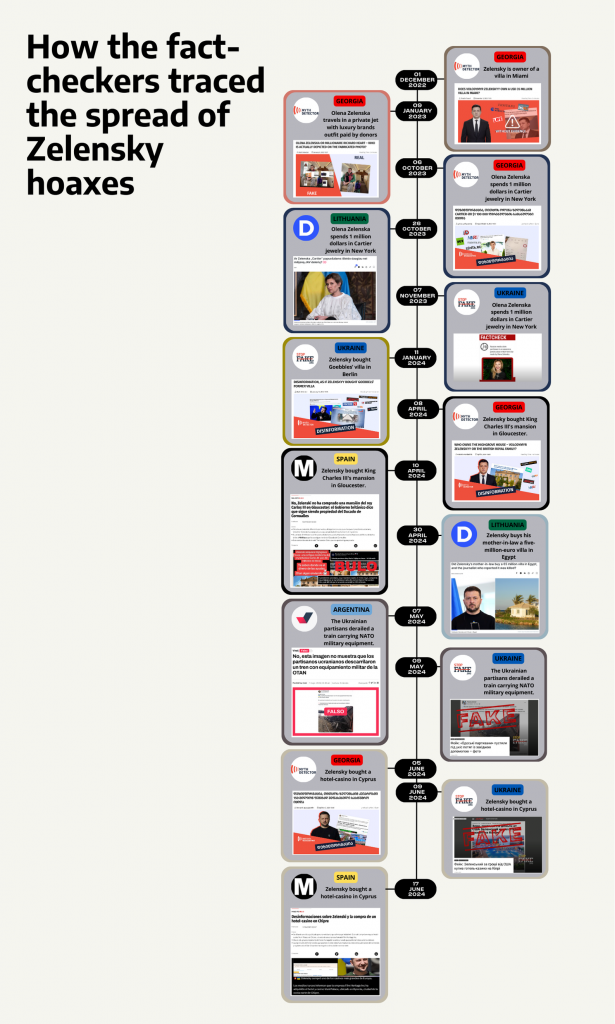
This research has been carried out following a methodology that includes a scale of risk values that points out if a content is part of a disinformation campaign, according to the following criteria: channels where the disinformation has been disseminated, countries in which it has circulated the same disinformation content, platforms on which it has been shared and identified narratives.
Who participates in this project?
This collaborative project, funded by the National Endowment for Democracy (NED), aims to improve the technological capabilities for the detection, analysis and classification of disinformation of fact-checking organisations in Eastern Europe and Eurasia: StopFake (Ukraine), Media Development Foundation (Georgia) and Delfi (Lithuania); while allowing interconnection with other Latin American organisations: Chequeado (Argentina), La Silla Vacía (Colombia); EsPaja (Venezuela) and Animal Político (Mexico) and Spain (Maldita.es) for the study of the circulation of disinformation.
How do we know that content is circulating at the same time in several countries?
Maldita.es has designed a centralised system that acts as a repository through which fact-checkers from Ukraine, Georgia, Lithuania, in addition to Maldita.es, can send the content they receive through their respective chatbots or that which they identify on the internet, in accordance with the methodology established for this project. If the content circulates in one or more countries, an alert is sent to the rest of the countries so that they can check if the disinformation is circulating in those countries and, if so, they indicate it in the shared system. Just because disinformation has been seen in a country does not necessarily mean that the fact-checking organisation publishes the verification, as it may not have been viral enough.


